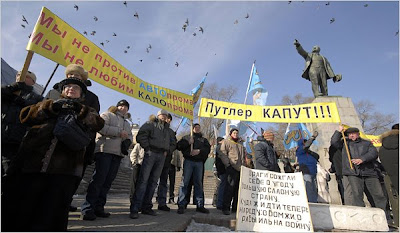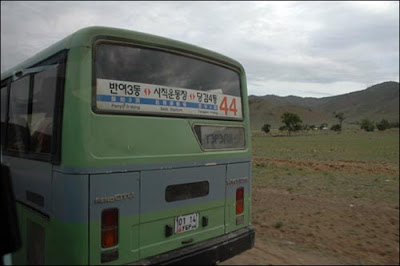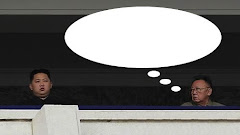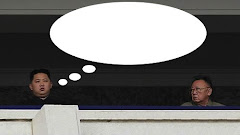 [above: Lenin tells the birds which way to go, but the birds won't listen. Stupid virus-carrying birds. Oh, and some people in really cold weather protesting Putin's policies.]
[above: Lenin tells the birds which way to go, but the birds won't listen. Stupid virus-carrying birds. Oh, and some people in really cold weather protesting Putin's policies.]
On the heels of news that Daewoo's planned 99-year lease of one-third of Madagascar's arable land had pushed anti-government Malagasies over the edge and into the streets, perhaps readying to topple the government in Antananarivo, there is an indication that in Russia's Far East there are protests over used Daewoo vehicles that have Moscow very, very worried.


Well, actually, the article about Vladivostok's "thriving trade in secondhand vehicles" only mentions Japan, but I know from a woman from Vladivostok, which is less than a hundred miles from North Korea and has long had a sizable Korean population, that Korean cars are fairly well represented as well. Even then, the Daewoos are probably way outnumbered by Hyundais and Kias, but I like the symmetry with the Madagascar situation: the thought of Daewoo causing governments to collapse all around the globe.
Anyway, it seems that thousands have been protesting in Russia's 600,000-strong Pacific outpost, where January lows and highs range from -17°C to -9°C (1°F to 15°F). You've gotta be pretty pissed off at your government to go protesting in weather like that. I would be at home nursing a nice steaming cup of hot chocolate and a bowl of sundubu.
As you might have guessed, economic policies are what's behind the anger. Moscow has reacted to the global financial crisis "by imposing steep tariffs" on the secondhand vehicle trade. In Vladivostok, where Russian vehicles are eschewed for Japanese ones, this has angered locals:
To wander through Vladivostok is to quickly understand why the tariffs are provocative. The people delight in driving used cars from Japan, which is only 500 miles away, saying that they are of far higher quality than Russia’s domestic models.When times were good, Putin's policies had been popular, but now even local officials from his own party are joining the bandwagon:
As a result, the streets offer a jarring sight: used Toyotas, Hondas and other Japanese vehicles, with steering wheels on the right side (in Japan, cars are driven on the left), being driven on the right side of the road. It is unusual to see a car with a Russian brand.
When the economy was surging, Mr. Putin’s government had widespread support, and the opposition was marginalized. Now that times are tough, events in the Far East suggest broader rumblings. And senior officials are no doubt aware that this maritime region, which borders China and North Korea, has historically been prone to political instability because it is so far from Moscow.As I've noted many times, Russia had been creeping back toward dictatorship opposed toward Washington. With Putin's push for a change in policy that would allow him to take back the presidency until 2021, and his push for Kyrgyzstan to close a US air base that is "key to military operations in Afghanistan," it appears that the "creeping" has become "leaping."
The tension has shown no signs of diminishing, and in late January, another demonstration in Vladivostok drew more than 1,000 people. The Communist Party, seeking to capitalize on the tariff issue, joined in. Marchers chanted, “Resign, Putin!” and held up caricatures of Mr. Putin, the prime minister, and President Dmitri A. Medvedev.
It should be no surprise, then, that in Putin's Russia, the Vladivostok car dealers' demonstrations would be met with threats violence because of fears they might trigger wider protests:
The car dealers’ demonstrations in Vladivostok in the past two months have drawn thousands of people, more than events sponsored anywhere in Russia by liberal opponents of Vladimir V. Putin. The government grew so alarmed in late December that it took the extraordinary step of sending special riot police officers to Vladivostok from Moscow, nine hours away by plane, to break up one rally.The government's side of the story?
Some participants were beaten and briefly arrested, and others said that they had recently received menacing phone calls from the security services ordering them to stop criticizing the government.
Senior officials have portrayed the organizers as nefarious profiteers controlled by foreign agents who want this region to secede from Russia. Behind the scenes, though, it appears that the Kremlin is concerned that resentment over the tariffs will continue to spread from the car dealers to the general population — and turn into a bigger backlash over the government’s handling of the financial crisis.
A vice governor, Yevgeny V. Khokholkov, accused auto dealers of trying to lure people to protests by spreading false rumors that cars with right-hand steering wheels would be banned. He said the Moscow riot police disrupted the rally on Dec. 21 because it was not authorized and because earlier protests had become disorderly.Banning right-hand vehicles? Well, that would just mean more Hyundais instead of Hondas.
And lest anyone think I'm making this Korean-vehicles-in-Vladivostok stuff up, take a look at the erstwhile Seoul Metropolitan Bus in front of Vladivostok Station (photo from Wikipedia). It appears it still has the Korean-language destination signs on it (for Seoul destinations, of course).

[above: "신촌에 가요?"]
My favorite example of the Korean-bus-where-it-doesn't-belong theme came from the Marmot's Hole:

But secondhand Korean vehicles can be seen all over East Asia. Half my taxi rides in Manila were in former Korean taxis, still with all the various Korean-language signs inside, including the no-smoking warning.
Sphere: Related Content






















No comments:
Post a Comment
Share your thoughts, but please be kind and respectful. My mom reads this blog.